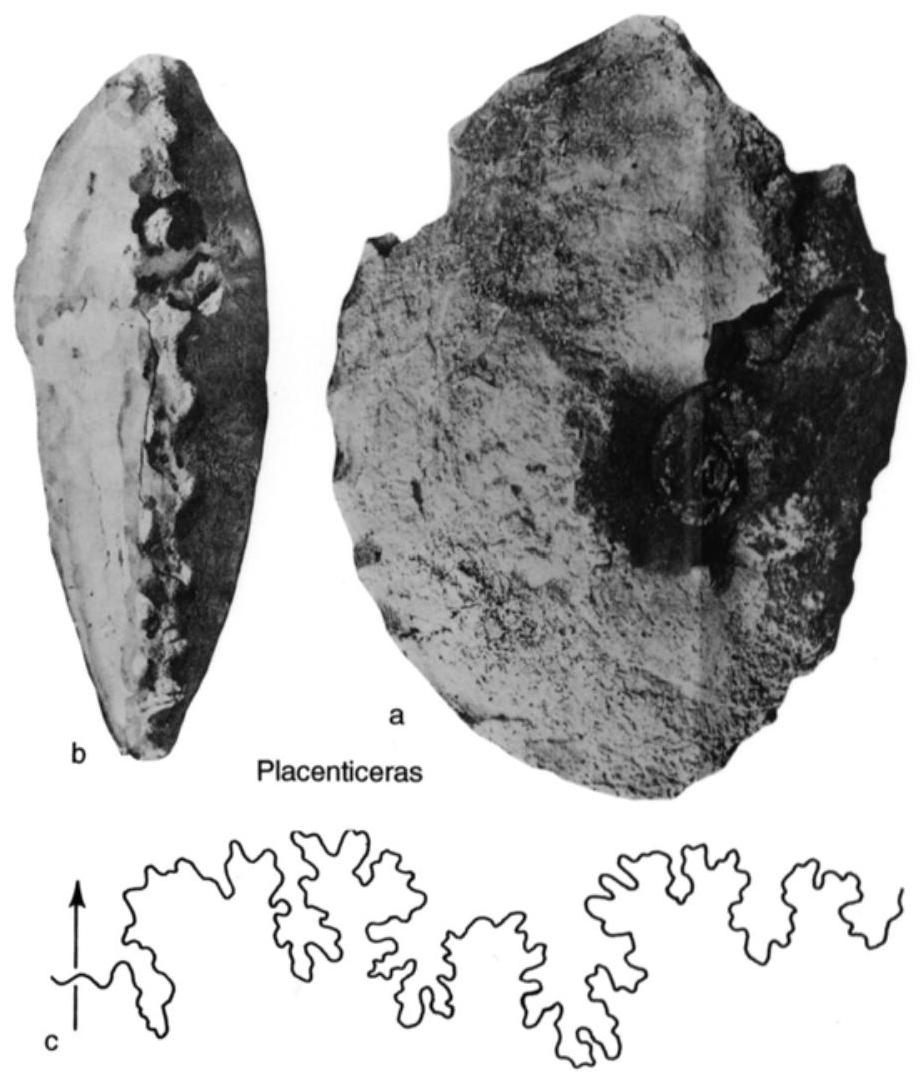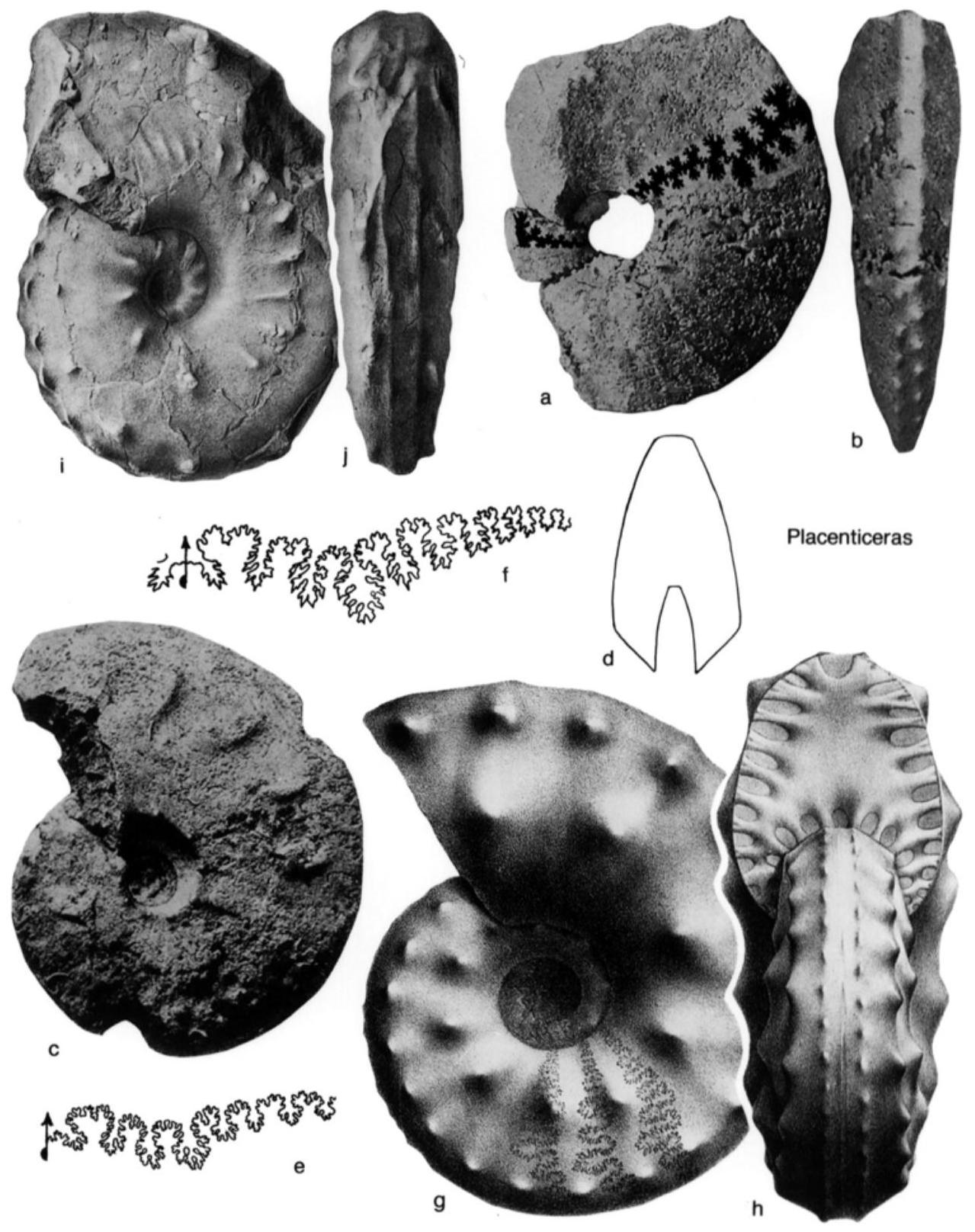Welcome to the Treatise on Invertebrate Paleontology!
Please enter a genera name to retrieve more information.

Placenticeras
Classification
Phylum:
Mollusca
Class:
Cephalopoda
Subclass:
Ammonoidea
Order:
Ammonitida
Suborder:
Ammonitina
Superfamily:
Hoplitaceae
Family:
Placenticeratidae
Formal Genus Name and Reference:
Placenticeras MEEK, 1876, p. 462
Type Species:
Ammonites placenta DEKAY, 1828, p. 278, OD
Images
(Click to enlarge in a new window)
Fig. 98a, b. P. grossouvrei Semenov, Cenomanian, Mangyshlak, X0.75 (Semenov, 1899), - Fig. 98c. P. mediasiaticum (Luppov), Cenomanian, central Asia, X 2 (Marcinowski, 1980), - Fig. 99a, b. *P. placenta (DeKay), Campanian, New Jersey, X 1 (Hyatt, 1903), - Fig. 99c-e. P. fritschi Grossouvre, Coniacian, France, X 1 (Grossouvre, 1894), - Fig. 99f-h. P. guadaloupae (Roemer), Campanian, Texas, X 0.5 (F. A. Roemer, 1852), - Fig. 99i, j. P. bidorsatum (Roemer), Lower Campanian, Germany, X0.75 (Müller & Wollemann, 1906)
Synonyms
Placentocerus; Diplacomoceras; Stantonoceras; Ammonites guadaloupae; Proplacenticeras; Pseudoplacenticeras; Gissarites; Parastantonoceras; Karamaites; Karamaiceras; Turkmenites; Kopetdagites; Mediasiceras; Beschtubeites; Asiatostantonoceras; Baghiceras; Malwiceras; Placentoscaphites; Sancarlosia
Geographic Distribution
France, Spain, Germany, Poland, eastern Africa, Madagascar, Israel, central Asia, southern India, British Columbia, USA, Mexico, Colombia
Age Range
Beginning Stage in Treatise Usage:
Lower Cretaceous (Upper Albian)
Beginning International Stage:
Albian
Fraction Up In Beginning Stage:
50
Beginning Date:
106.85
Ending Stage in Treatise Usage:
Upper Cretaceous (Lower Campanian)
Ending International Stage:
Campanian
Fraction Up In Ending Stage:
50
Ending Date:
77.91
Description
Populations show great variability, ranging from compressed, involute forms with con- vergent, slightly convex sides, narrow, tabulate ven- ter, no to weak, falcoid ribs, long umbilical bullae, and inner and more numerous outer ventrolateral tubercles to forms with similar inner whorls, but outer becoming more evolute, rectangular to square in section, with more prominent umbilical and ven- trolateral tubercles, the inner of which, originally midlateral, may move outwards to form the ventro- lateral margin while the outer may disappear. In any population macroconchs comprise the larger, more compressed, and more feebly ornamented forms. The relative size of sutural elements varies slightly with time; early species tend to have the 4th lateral lobe smaller than the 5th. Placenticeras was formerly distinguished from Karamaites by progressive in- crease in number of sutural elements, by develop- ment of strong dimorphism with strongly orna- mented microconchs, and by progressive outward migration of umbilical tubercles to midlateral and of midlateral to inner ventrolateral position. How- ever, strongly ornamented microconchs are now known from Cenomanian and there seem to be no valid grounds for dividing the slowly evolving se- ries.
References
Museum or Author Information
Classification
Phylum:
Mollusca
Class:
Cephalopoda
Subclass:
Ammonoidea
Order:
Ammonitida
Suborder:
Ammonitina
Superfamily:
Hoplitaceae
Family:
Placenticeratidae
Formal Genus Name and Reference:
Placenticeras MEEK, 1876, p. 462
Type Species:
Ammonites placenta DEKAY, 1828, p. 278, OD
Images
(Click to enlarge in a new window)
Fig. 98a, b. P. grossouvrei Semenov, Cenomanian, Mangyshlak, X0.75 (Semenov, 1899), - Fig. 98c. P. mediasiaticum (Luppov), Cenomanian, central Asia, X 2 (Marcinowski, 1980), - Fig. 99a, b. *P. placenta (DeKay), Campanian, New Jersey, X 1 (Hyatt, 1903), - Fig. 99c-e. P. fritschi Grossouvre, Coniacian, France, X 1 (Grossouvre, 1894), - Fig. 99f-h. P. guadaloupae (Roemer), Campanian, Texas, X 0.5 (F. A. Roemer, 1852), - Fig. 99i, j. P. bidorsatum (Roemer), Lower Campanian, Germany, X0.75 (Müller & Wollemann, 1906)
Synonyms
Placentocerus; Diplacomoceras; Stantonoceras; Ammonites guadaloupae; Proplacenticeras; Pseudoplacenticeras; Gissarites; Parastantonoceras; Karamaites; Karamaiceras; Turkmenites; Kopetdagites; Mediasiceras; Beschtubeites; Asiatostantonoceras; Baghiceras; Malwiceras; Placentoscaphites; Sancarlosia
Geographic Distribution
France, Spain, Germany, Poland, eastern Africa, Madagascar, Israel, central Asia, southern India, British Columbia, USA, Mexico, Colombia
Age Range
Beginning Stage in Treatise Usage:
Lower Cretaceous (Upper Albian)
Beginning International Stage:
Albian
Fraction Up In Beginning Stage:
50
Beginning Date:
106.85
Ending Stage in Treatise Usage:
Upper Cretaceous (Lower Campanian)
Ending International Stage:
Campanian
Fraction Up In Ending Stage:
50
Ending Date:
77.91
Description
Populations show great variability, ranging from compressed, involute forms with con- vergent, slightly convex sides, narrow, tabulate ven- ter, no to weak, falcoid ribs, long umbilical bullae, and inner and more numerous outer ventrolateral tubercles to forms with similar inner whorls, but outer becoming more evolute, rectangular to square in section, with more prominent umbilical and ven- trolateral tubercles, the inner of which, originally midlateral, may move outwards to form the ventro- lateral margin while the outer may disappear. In any population macroconchs comprise the larger, more compressed, and more feebly ornamented forms. The relative size of sutural elements varies slightly with time; early species tend to have the 4th lateral lobe smaller than the 5th. Placenticeras was formerly distinguished from Karamaites by progressive in- crease in number of sutural elements, by develop- ment of strong dimorphism with strongly orna- mented microconchs, and by progressive outward migration of umbilical tubercles to midlateral and of midlateral to inner ventrolateral position. How- ever, strongly ornamented microconchs are now known from Cenomanian and there seem to be no valid grounds for dividing the slowly evolving se- ries.

